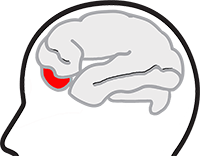Differential diagnosis
A diagnosis is generally made after examination with a specialist, as cluster headache has specific characteristics.
However, it will only be confirmed after further clinical examinations to exclude any other form of primary or secondary headache.
Why a differential diagnosis?
It is important not to confuse cluster headache with other types of headache.
Indeed, confusion is very common among patients and the disease is unfortunately not well known in the medical sector.
In addition, a neurologist specialised in headaches should exclude any other pathology that may induce a secondary headache. In fact, these should absolutely be detected as their consequences are often more serious:
- Thunderclap headache
- Meningitis
- Subdural hematoma
- Stroke
- Carotid dissection
- Temporal arteritis
- Result of head injury
- Medication-related
- etc.
Additional examinations confirm the final diagnosis
Frequent diagnostic errors
From the patient (self-diagnosis):
- Sinusitis
- Ocular Conditions
- Toothache
- Migraine

Sinusitis is generally frontal or maxillary. The associated pains are located “around” the eye.

Unnecessary teeth extractions are unfortunately too frequent.
Frequent diagnostic errors
From the medical side (non-headache specialists):
- Migraine
- Tension headache
- Trigeminal neuralgia
- Paroxysmal hemicrania

Tension headache.

Trigeminal neuralgia.
Difficulties in differential diagnosis
Similar to cluster headache:
- Trigeminal neuralgia
- Chronic paroxysmal hemicrania
- SUNCT syndrome
In order to allow distinctions, the following table shows you possible “overlaps”.
Hence the importance of asking precise questions to the patient.
| IHS Infos on: | SUNCT | Paroxysmal hemicrania | Cluster headache | Trigeminal neuralgia |
| Sex-ratio | W > H | W>H | 1 W/4 M | W > H |
| Duration of attacks | < 3 minutes | 2 to 30 minutes | 15 to 180 minutes | 2–3 s to some minutes |
| Frequency of attacks | 5 to 80 per day | 2 to 40 per day | 1 to 8 per day | 5 to > 100 per day |
| Pain Laterality | Strictly unilateral | Strictly unilateral | Strictly unilateral | Mostly unilateral |
| Pain distribution | Ocular | Orbitotemporal | Orbitotemporal | V2/V3 > V1 |
| Type of pain | Stabbing | Pulsatil with photophobia and phonophobia | Crushing, tearing, ice pick | Electric shock, burn |
| Pain intensity | Severe | Severe to very severe | Very severe | Very severe |
| Dysautonomic signs | Presents | Presents | Presents | Occasional eye congestion |
| Impact of attacks on activity | Activity possible but difficult | Normal activity not possible | Normal activity not possible, agitation | Brief sideration during the shock |
| Attack triggers | Chewing, cold wind on the face, speaking, touching the face, bright light. | Irritation, excitement, sudden change of position, hormonal change. | Nothing, sleep, alcohol intake | Trigger areas: Talking, chewing |
“Classic” additional examinations
- EEG -Electroencephalography
- MRI
- Evoked potentials

Electroencephalography

Evoked potentials

